
.........................................................................................................................................................................................................
societa colnago | colnago c40 | colnago c40hp | colnago c50hp | colnago dream |
colnago teams since 1968 | robert millar c40 review | colnago clx | colnago c50 2007 |
colnago arte 2008 | colnago eps | colnago cx-1 | ernesto colnago interview 2008 |
colnago clx centaur | colnago ace | colnago super | colnago c59
colnago clx 2.0
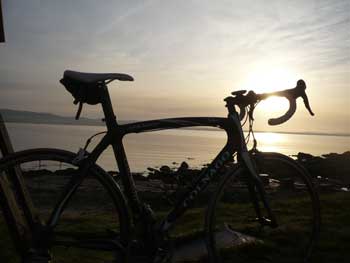
it's almost four years since i had the pleasure of conducting the first test/review of colnago's clx carbon bicycle. there had already been sharp intakes of breath on a grand scale across the cycling press and the forums after cambiago had announced that a carbon bike was to emerge from taiwan, but that was more due to some perhaps ill-judged statements of previous years. mr colnago had long trumpeted that his carbon frames would always be made in italy, despite many of his competitors having already found it necessary to move fabrication east as a simple economic necessity. ernesto is, thankfully, more moved by passion than by numbers in the excel spreadsheet.
of course, carbon fibre has no idea of its nationality, and the moulds and design had both been completed in cambiago prior to shipping to one of the top taiwanese factories, the man/men responsible for carbon layup being personally selected by colnago. so essentially the clx was still a colnago, but made in a different country.
there was also a finely timed irony that, as i finished a review of the colnago uk built clx with centaur gearing, colnago saw fit to release the clx 2.0, rendering my writings somewhat derelict.
this second coming of taiwanese carbon fibre was met with little in the way of aghastness; in the intervening years we have had the cx-1, a sculpted carbon frame only with yet another feature strongly denied by mr colnago, something he once said we could save our breath on: one would never see the inside of a head-tube on his frames. i refer to the colnago hts semi-integrated headset which not only appears on the cx-1, but the ace, the top of the range eps, and now the clx 2.0.
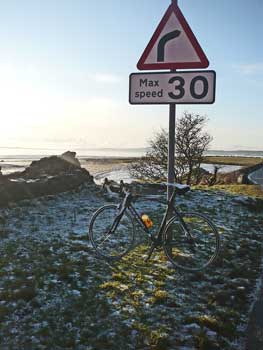
it's likely this latter that gives rise to the new, chunkier shape borne by the clx. place the headset inside any tube, and you either have to make the component smaller or the tube larger; it would go very much against the grain to reduce the diameter of the steerer, because stiffness demands larger, and larger still. thus, fitting the colnago 1.125" hts inside the head-tube has increased the size quite noticeably, the corollary of which is the necessity (desire?) to enlarge the two tubes that join to it. just as a brief aside here, on a monocoque frame, consisting of two distinct, mirror image carbon halves, it is open to debate as to whether we can still knowingly refer to tubes. however, for the sake of brevity and clarity, i'll continue with the traditional nomenclature.
the down-tube is enormous, and this enormity helps encourage the bottom bracket area to similar hugeness. i can't help thinking that this degree of stiffness, implied if not delivered, on many of today's carbon frames has to be considerably far past the extent of human input to cause undue movement. however, in the case of the clx 2.0, the sculpting of the bottom bracket is at least aesthetically pleasing. the top-tube is also a deal larger than before, describing a pleasant convex curve on its way to the seat tube. for the first time, sequence is maintained: the metal plate engraved with the serial number is still in situ on the lower underside of the down-tube.
the seat-tube is not round, as indeed it wasn't on the original; airfoil on its side, with a subtle cutout at the rear to accommodate the rear wheel. the visual result of the three main pipes and the merging of same is very pleasing, especially in the colour scheme of the test bike; essentially clear-coated carbon with some red and white swoops and a multitude of colnago decals. both top and down tubes feature subtle bulges and fluting, which experience has taught are unlikely simply there for aesthetic reasons.
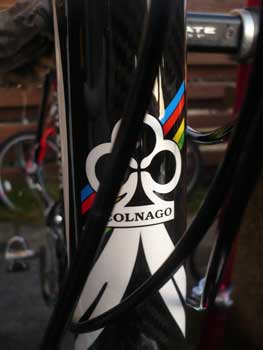
although the main frame is of monocoque construction, the rear triangle is glued; it's a variation on colnago's famed b-stay, but rather than the hp stays seen on the c40 and then the c50, the chainstays are colnago's piece de resistance; the leaf stays. meeting those at the rear dropouts, the seatsays split from the monostay just past the brake bridge in a top tube continuing convex arc.
many another frame builder would fit a regular, round seatpost, even into a teardrop shaped seat-tube, but in keeping with the original clx, colnago have matched post with tube. a shortage of length it most certainly does not have, though if extended to its full height, i shudder to think of the rider's profile when trying to rest hands on lever hoods or bars. the upside of a proprietary cross section such as this is the knowledge that it is, as brian smith once humorously pointed out, impossible not to have the saddle aligned with the top tube. the only real downside i can think of is that a post from another source cannot be used with the clx 2.0.
the front fork has seen an increase of girth in every direction. the legs are vertically fluted and very chunky: the fork crown makes the word substantial look barely adequate. a full carbon steerer leads through the hts, but the downside is still those horrible lawyer's lips that render a quick release anything but. the nanny state wins again. since this is a sloping frame (something else colnago promised never to do), sizing is slightly different: basically the 52cm tested is the equivalent of a 56cm traditional.
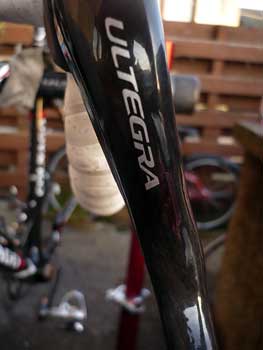
it is noticeable that the rear brake outer cable runs the full length from bars to caliper, rather than baring itself between cable stops. i have always equated such with less than frictionless operation, but i have concluded that it is likely due to the curvature of the top tube. using cable stops would necessitate the inner running in a straight line, which would either leave the wire exposed, disturb the graceful lines of the clx, or both. perhaps a minor case of style over substance?
of course, that describes only the frame; to turn it into a bicycle, a smattering of fine componentry is required. the demands of economics and manufacturing location plays its own part in this, because while campagnolo do manufacture some of their lower end offerings in the same part of the world (mostly veloce), the upper regions can likely only be satisfied by shimano and sram. colnago have yet to apply the latter to any of their bicycles, so in this case gears and sti levers are from the latest ultegra groupset, with cables hidden under the bar tape. great joy.
the brake/gear levers now sport carbon blades, and re-sculpted lever hoods. however, despite their modernity and position on the shimano ladder, the junction between blades and hinges looks unfinished; almost like prototypes. the levers themselves look, to all intent and purpose, as if they'd been broken in transit; they now splay outwards, instead of following the perpendicular line of the bars. ergonomics. front and rear gear mechs are from the same groupset, while the carbon, compact, team issue chainset is from colnago's near neighbour, fsa. the brakes too are from the same supplier, only this time they're painted red and white with a colnago tagline on the top of the caliper. an interesting point that i nearly missed, and i'm not sure if this is a shimano thing or a colnago thing, but the gear cable outers proclaimed gore-ride on. a nice touch.
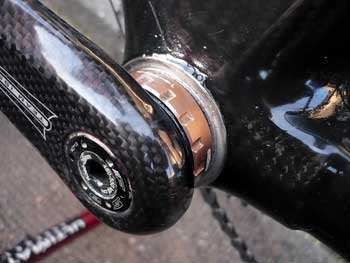
the wheels rack the number of major suppliers to three, being racing fives from fulcrum, a subsidiary of campagnolo, and, as far as i know, produced in the far east. these are shod with, in this case, white and black vittoria rubino pro tyres, colour matching at its finest. aluminium alloy bars and stem are also supplied by fsa; it would be nice to have seen carbon here, since pretty much everything else is, but i would think the price point prevents this happening. that said, there really isn't anything against metal in this location.
despite external colnago branding on the red and white saddle, cambiago continues its association with prologo, held fast to the post with colnago's usual twin bolt mechanism.
riding
three weeks off the bike is hardly the ideal situation in which to commence bicycle testing; the first slew of kilometres were purgatory, both for those weakened legs and the softened posterior. this was not aided by my riding in this pathetic condition for a total of three hours on the first day. i had no idea that fitness could be so comprehensively dismissed in such a short period of time, but rather than blame the clx for this enveloping discomfort, i did my level best to enjoy the ride over the next two days, before continuing for a further seven. as a degree of fitness began to return, it became a lot easier to discriminate, and it was most satisfying to realise that most of the problem was mine rather than the colnago's.

having ridden a clx 1.0 for a three month period this past summer, i had a better recollection with which to compare than might otherwise have been the case. rationalising what works and what doesn't falls into no regulated order: bars, levers, saddle, comfort. points of connection are hard to ignore. my c40 rides with 44cm bars, so one level of discomfort took a tad longer to disappear than some of the others; the fsa bars on the clx measure up at only 40cm. not ideal in my case, but the clx 2.0 arrives as a complete bike, parts on which your local dealer is unlikely to be too keen to swap out on a whim. the bar width became less of an issue over time, but the sting was alleviated by the fitting of a 130mm stem. experience has taught that the majority of bicycles arrive with 1cm less.
colnago's sloping format gives rise to a different set of comparison values to find the ideal frame size; a bit like converting kilometres back to miles. the c40 is a 54cm regular frame, equating to a 50cm sloping. the review model was a couple of centimetres on the large side, but top tube and stem lengths suited fine. just the stand-over height meant that boy soprano was only a sudden stop away.
read any contemporary bicycle brochure, and you could cheerfully start a party game out of the number of times the word stiffness appears in the text. just how much stiffness we need in a bicycle is open to debate, but it's something that is immediately apparent on riding the clx 2.0; and it's not all bad. in fact, i'd go so far as to say that probably none of it is. the notion of sticking the headset inside the head-tube can do little else but stiffen the steering, but the increase in tube size has continued this proportionally across the bike. generally, my luddite tendencies would not equate this with a good thing, but colnago have managed the seeming impossible by marrying ride stiffness with no appreciable loss of comfort. the eps springs to mind.

i have no more sophisticated testing equipment other than a pair of well-used legs, and i tend to judge a frame's characteristics by matching leg feedback with reference to my limited, but slowly-increasing experience in such matters. pedalling hard should, ideally, be replied to with a subtle spring in the step, something i can best describe as an indefinable follow through at the bottom of each pedal stroke. it brings a smile even when ascending hard closes on purgatory. number two in the clx pantheon reaches that state, the reason for which is, i'm inclined to believe, those leaf chainstays.
riding across those carefully prepared roads kept for special occasions, incorporating a smattering of cattle grids for good measure, transmitted the knowledge of those surfaces; you'd know you were on bumpy ground. but the actual vibrations were isolated by the frame and forks. and while it was doing this, the whole bike gave off an incredibly satisfying carbon noise reminiscent of a really expensive pair of wheels from the black stuff. a marketable sound if ever i heard one.
stability under duress has long been one of colnago's identifiable traits; round corners, down hills, round downhill corners, and at speeds below 4kph. i can see i'd have to justify riding a colnago at only 4kph, but a man's got to do what a man's got to do. the frame's inherent stiffness does not go unsung: fulcrum racing fives fall into the category of boutique wheels, one step up from the bottom of the price rung. i would contend that wheels of this ilk have far fewer spokes than really necessary, something that often manifests itself by varying degrees of rear brake rub when sprinting or giving it some welly uphill. it appears that the build of the clx frame has successfully negated this latter trait: despite having the calipers set closer than considered normal, i failed miserably to encourage rim to meet with brake shoe, despite some mean-spirited hammering on the inclines. just think how you'd get on with a proper set of wheels.

the result of modern bicycle economics dictates that many a complete bike originating in the far east arrives with all, or part of, a shimano groupset. while playing the game of campagnolo enthusiast has its fun moments, in point of truth, japan brings a slightly different flavour of technical excellence. the components that fulfil one of the major points of contact are the combined gear and brake levers. up til now, these have been a personal bone of contention, for no matter how i've tried, i have been unable to find a suitable level of comfort on shimano's sti lever hoods, while the cables shooting out from the inner surfaces have, irrationally i know, been a source of constant irritation.
with their latest levers, shimano have finally relented and run the cables under the bar tape, while taking the opportunity to redesign the lever assembly in the process. so now i find myself with no rational objection to riding shimano. in fact, quite the contrary; the new design is positively agreeable on any length of ride, while the outward sloping of the lever blades makes them much easier to access from the drops. additionally, the sculpting inward of the blades just below the lever tops is an ergonomic success when grasping and braking from the hoods. shimano have also shortened the throw of the left lever, making it an easy and swift move to change from inner to outer ring. shifting the other way is a bit more abrupt, but since this redesign has also enabled trimming of the front mech to avoid chain rub in any gear, anything can be forgiven.

however, my age-old complaint concerning the 50/34 chainring arrangement still stands. over the past few weeks, i have almost perfected the left-right, one-two-step, where shifting down the block eventually results in the necessity of shifting from inner to outer at the front, followed by a click back up one sprocket at the back. and just in case you think this a personal foible, i have been mildly scientific by checking my cadence on an appropriately fitted garmin; if i wish to remain within deigned parameters, then the one-two-step makes perfect sense. of course, a simple change to 48/34 or 50/36 would likely cure this.
what was less easy to forgive was the shearing of the front cable clamp bolt during the trimming process, just as the review neared its final throes. not having a replacement bolt to hand, nor wishing to remove the chain to enable a replacement front mech (bolt-on), sadly the test was brought to a rather abrupt end at this point.
the colnago badged fsa brake calipers are, as far as i know, the very same actuators fitted to the previously tested colnago ace. yet strangely, their behaviour seemed at variance with their antecedents. i cannot say that the brakes gave any real cause for concern: stopping power was not what you'd call absent, but i wonder whether the shimano levers have a lessened degree of pull than the campagnolo levers on the ace. braking just felt a tad on the skittish side. of course, it could also have been the braking surface on the wheels, but i haven't come across this before with fulcrums, and i doubt very much if it was the brake shoes themselves. while colnago undoubtedly enjoy reinforcement of the corporate branding across almost everything in sight, perhaps they should take shimano literally with their total integration slogan, and marry ultegra levers with ultegra calipers.
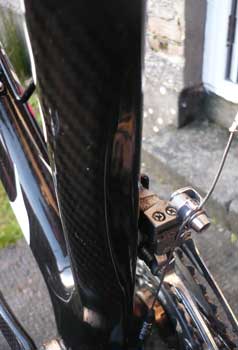
despite my contention that wheels really ought to have more spokes and more crossings of spokes, the fulcrum racing fives appear to have done their job admirably. i say appear to have because, to be honest, in motion, they did exactly what you'd expect a pair of wheels to accomplish. if the level of comfort was taken care of by the frame, then they did nothing to undermine this. i find myself increasingly impressed with vittoria rubino pro tyres, ever since colnago started fitting these instead of michelins. tastefully matched to the black and white of the frame, they received a harder december than they had likely envisaged, with frost, snow, ice, grit and the occasional bout of torrential rain. they have a great deal to recommend them in both their flexibility and wear characteristics.
the prologo saddle was a prologo saddle. i can't say it was the most comfortable i have ever ridden, but was still a long way from being the most uncomfortable. it's sort of unfair to criticise any saddle in a bike test, other than for manufacturing defects, because we all have widely varying posteriors, in both senses of the word. and unless you have a penchant for slivers of carbon atop braided rails, it shouldn't cost that much to change if it is not to your bum's liking.
the clx 2.0 is a notable improvement over version 1.0, and it was pretty darned good in the first place. the increase in tube diameter gives little cause for concern in the comfort
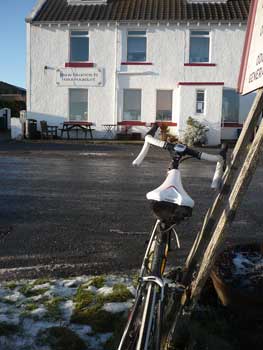 department, but has contributed to the creation of a more together bicycle. the clx 2.0 is available as either a complete bike with ultegra gearing, or as a frame only, in a variety of colour schemes, some of which are quite inspired for a change. i'm not sure that colnago will be happy about my saying so, but this bike provides very close competition for its bigger brother, the cx-1 (available as a frame only) which costs only a few hundred pounds less than a complete clx bicycle.
department, but has contributed to the creation of a more together bicycle. the clx 2.0 is available as either a complete bike with ultegra gearing, or as a frame only, in a variety of colour schemes, some of which are quite inspired for a change. i'm not sure that colnago will be happy about my saying so, but this bike provides very close competition for its bigger brother, the cx-1 (available as a frame only) which costs only a few hundred pounds less than a complete clx bicycle.
colnago uk list the clx 2.0 as available with campagnolo centaur (built inhouse in the uk), but as yet, no pricing. the clx 2.0 complete bicycle costs £2599 or as a frame only at £1699.
photo slideshow
posted on thursday 31 december 2009 societa colnago | colnago c40 | colnago c40hp | colnago c50hp | colnago dream |![]()
colnago teams since 1968 | robert millar c40 review | colnago clx | colnago c50 2007 |
colnago arte 2008 | colnago eps | colnago cx-1 | ernesto colnago interview 2008 |
colnago clx centaur | colnago ace | colnago super | colnago c59